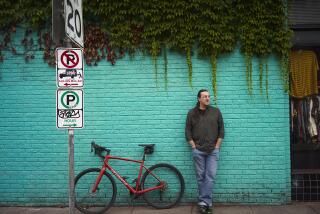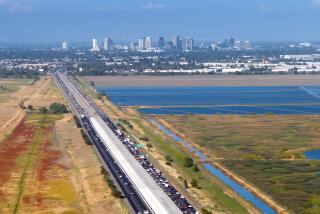Practicing Safe Cycling in an Unsafe, 4-Wheeled World
- Share via
Warning: With this edition of Street Smart, we rip out our heart and strap it throbbing to our sleeve.
Today’s tirade--er, topic, is bikes.
Street Smart is proud to be a bandy-legged, exhaust-sucking bug-swallower of a daily cyclist, prone to defiant gestures and fits of righteous anger when wronged by the four-wheeled world.
As wonderful as cycling is, it is hard enough to perch on an aluminum groin-torture device and six square inches of rubber-skinned air without having to dodge the likes of you.
You know who you are.
You hug the shoulder and force us into ditches. You fling car doors open in our faces without checking your mirrors.
You pull out in front of us without warning, as if we should yield just because your destination matters more and your huge vehicle could pummel ours to scrap.
We get so mad we could just spit. And we spit pretty accurately, so watch it.
****
Dear Street Smart:
Thank you for your continuing efforts to promote safe bicycling.
Please expand on your recent comments on right turns for motorists into the bike lane. I have experienced numerous instances in which a vehicle turns right from the “right lane,” directly in front of my path in a marked bike lane.
Kindly remind them that they may overtake and pass me, if it doesn’t impede my progress (just like another motor vehicle) and if it is safe to do so.
Otherwise, drop a safe distance behind me and wait your turn. In any case, please do not intercept me at the corner by speeding up and cutting in front of me!
Jeffrey L. Wissot, Westlake Village
*
Dear Reader:
There are laws to deal with thoughtless jerks like these.
Bicycles, like cars, are vehicles under the law. And their operators must follow all rules of the road, says California Highway Patrol Officer Michael Condon.
“The guy that turns right in front of the bicycle is in violation,” he says. “If there had been an accident because he failed to see a bicycle, [the driver] would be at fault.”
Bad bicyclists can be almost as dangerous--and illegal--as bad drivers, although usually they are mostly a hazard to themselves.
You cyclists who ride against traffic, ignore stoplights and stop signs, drift across traffic lanes without signaling, cycle while drunk or pedal without a helmet (although the helmet law applies only to children) are asking for it.
You also make responsible cyclists look bad, so please--if not for the rest of us, then for yourself--obey the traffic laws as if you were driving a car.
****
Dear Street Smart:
Some traffic signals, especially the one at Erbes Road and Avenida de Los Arboles in Thousand Oaks, are controlled on a demand basis: If there is no traffic, the light never turns green.
When those lights were installed in 1995, I asked Thousand Oaks traffic engineer Jeff Knowles about putting a sensor into the pavement of each bike lane so that bikes would not have to move into the traffic lane to trip the light.
He said he’d look into installing a button on a post for bikes, but neither solution was used.
Recently, these streets were resurfaced, completely erasing marks that told bikers where the sensors are. There needs to be a visible sensor somewhere for the bicyclist either to ride over or push by hand without getting off the street. The pavement type is preferable so the cyclist doesn’t have to take his hand off the handlebars.
Michael Pershing, Thousand Oaks
*
Dear Reader:
Mixed news on the sensor front.
Knowles says he has neither plans nor money to retrofit existing traffic signals with bike sensors or buttons.
On the other hand, Thousand Oaks plans to build five new signals--including three on Lynn Road, complete with push buttons facing the bike lane, he says. The intersections will also have special bike sensors in the left-turn lanes so cyclists don’t have to wait for cars to pull up behind and trip the lights before they can turn left onto busy boulevards.
Of the 15 signal lights going in this year, half are on bike routes and will have push buttons. But converting the rest of the city’s 71 signals would be too costly, he says. “It would have to be part of a citywide project, if we were going to adopt the plan and budget several hundred thousand dollars.”
But be patient and persistent, bicyclists. Our numbers are growing and the day may come when we have as much say as motorists in how traffic controls should be designed.
****
Dear Street Smart:
As one who bicycles regularly throughout Ventura County, I have a question I’ve been burning to ask.
What’s the deal with those official warnings I see stenciled in reverse order all over the roads? When I’m in my car, the messages notifying me of “AHEAD STOP” or “LANE BIKE” seem pretty senseless, given that my mind has been programmed to read from top to bottom.
It’s even more senseless to me that these messages appear exactly the same when I’m on a bicycle traveling only 15 mph.
The one that really burns me is the staunch admonition of “GNIKRAP ON” which approaches me one letter at a time on my rides between Santa Barbara and Ventura!
What kind of senseless bureaucratic rule dictates that signage be painted in this manner? I would literally have to get on my hands and knees and CRAWL down the lane to read the message in the order in which it was written. Could you enlighten me and other similarly confused people as to how this all got started?
Larry Lerner, Camarillo
*
Dear Reader:
At first we thought you were kidding, a prank letter from someone who cannot possibly be “confused” about the way pavement warnings are worded.
But then we got to wondering and thought, maybe he’s not. It always has looked pretty goofy.
“It’s because of the way people are traveling, they see the STOP first and then the AHEAD, so they’re reading it in sequence,” says Bob Brownie, a public works engineer for Ventura County. “The perception of the motorist moving on the road is STOP AHEAD.”
Don’t blame Ventura County, nor even Caltrans, which publishes road-signal guidelines followed by the county, he says. Just about every road agency in the nation follows the federal government’s Manual on Uniform Traffic Control Devices, which governs signs, signals and painted lines.
Your complaint about the Rincon’s GNIKRAP ON warning made Street Smart--and Caltrans engineer Robert Houle--laugh out loud.
“It never crossed my mind to think of it that way,” says Houle with a chuckle.
But the sign--apparently painted in an overly literal interpretation of the same guideline that gives us ZONE SCHOOL SLOW warnings--is there for the protection of cyclists like us, he says:
“It means no parking in that bike lane,” Houle explains. “We want [cars] to pull out of the bike lane and keep that clear for bicycles so they don’t have to move out in traffic to clear the [parked] cars.”
More to Read
Sign up for The Wild
We’ll help you find the best places to hike, bike and run, as well as the perfect silent spots for meditation and yoga.
You may occasionally receive promotional content from the Los Angeles Times.






